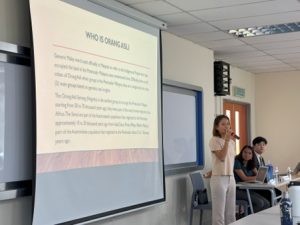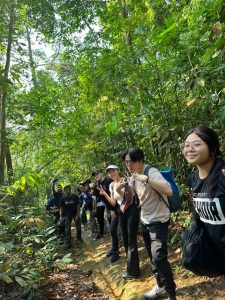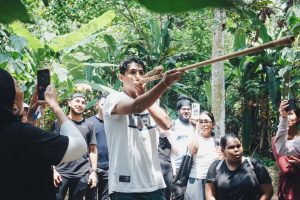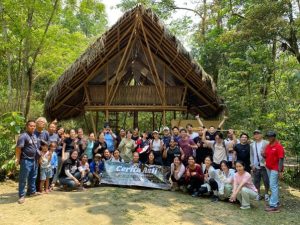At the INTI International College Subang’s Center for American Education (CAE), students had a unique opportunity to step out of their comfort zones and experience the life of the Orang Asli community in Perkampungan Orang Asli Serendah on October 27.

In her insightful talk, Nurul Najihah from JKOASM stressed the need to understand and clear misconceptions about the Orang Asli.
Under the guidance of Pak Elok, the head of the Temuan tribe, they delved into the art of jungle survival during a two-hour trek through the lush greenery. They learned to use blowpipes, enjoyed traditional Orang Asli dishes, and carefully collected jungle ingredients. This immersive experience offered them a glimpse into a way of life deeply connected to nature. Interacting with the usually reserved Orang Asli, the students discovered untold stories and forged connections that transcended differences.

Students participated in a two-hour jungle trek through lush greenery to get to the Orang Asli village.
Pak Elok, a 76-year-old tribal leader, shared his extensive knowledge of the jungle with the students, becoming a living encyclopedia of the forest. By the end of the day, the community received generous donations of RM500 each from Noodle Mansion and Lookoo, along with a significant RM3000 raised by the students, showcasing a heartwarming display of solidarity.
Maztini Ahmad Mahir, a senior lecturer, discovered a tightly-knit community where family bonds were the cornerstone of their society. Residents of Serendah balanced jobs in nearby towns with ventures into the jungle, foraging edible plants and crafting natural medicines, highlighting their deep connection to their environment.
She reflected on her findings, saying, “They were always together as a family – very close-knit. Everyone seemed to be helping one another.”
She also noted, “Their struggle, however, lay in the battle to preserve ancestral lands against the juggernaut of modern development. Despite their ancestors having lived in these areas for thousands of years, the absence of proper ancestral documents compelled them to fight for their land rights, preventing these lands from being overdeveloped and ruined by modern developments.”
She concluded, “I learned that the indigenous people were sidelined because society failed to understand them – their culture, way of living, and thinking.”
International student Ataly Charygulyyev from Turkmenistan was impressed by the well-structured environment of the village. He observed the clash between tradition and modernity, symbolised by nearby factories threatening the village, and saw the determination of Serendah’s residents to protect their way of life.
Ataly shared, “Before entering the forest, we had to ask for permission and blessings from the spirits of the forest as a sign of respect.”
He further noted, “The Orang Asli in Serendah connected with the broader society through well-structured roads and a progressive daily life. Sadly, the city’s expansion threatened their way of life as nearby factories attempted to destroy the forest where they lived.”
Student Coleen Tan Ker Ying was deeply moved by the cultural richness of the Orang Asli and emphasised the importance of respecting customs during visits. She stressed that the forest was not merely a backdrop, but a sacred space intertwined with the Orang Asli’s existence.

A student got to try blowpipe shooting at the Orang Asli village.
She stated, “Understanding and respecting the customs of the Orang Asli, including traditional greetings and rituals, was crucial during interactions.”
She continued, “Despite common perceptions of living in poor conditions without conventional entertainment, this trip reshaped my view. Orang Asli found happiness in their unique way of life. While it might appear challenging to those unfamiliar with this lifestyle, it was their chosen path.”
Student project leader Wong Chevenn shared intriguing beliefs he learned about, saying, “In the forest, there was a special tree called Kemayan used by the Orang Asli for medicine. They believed it had a soul, so you wouldn’t find it if you were looking on purpose – only if you were lucky.”
Wong challenged stereotypes, emphasising that the Orang Asli village, once considered secluded, had embraced modern life, dispelling misconceptions and welcoming interaction. He stated, “The Orang Asli were not close-minded or lagging as portrayed by the media.”
Student Leona Puhalanthy immersed herself in the simplicity of Orang Asli life, where daily chores, traditional cuisines, and a profound connection with nature were the essence of their existence.
She shared, “Hunting and gathering weren’t just survival tactics; they were traditions passed down through generations.”
“I was truly moved by how their community deeply connected with nature. Their everyday tasks, such as using herbs and working together, were all part of a close relationship with the environment. It made me appreciate the importance of living sustainably and left me deeply respecting our surroundings,” she added.
Nurul Najihah, a representative from the Orang Asli Network of Peninsular Malaysia (JKOASM), emphasised the importance of understanding and dispelling misconceptions surrounding the Orang Asli during her enlightening talk at IICS.
She shared, “The Orang Asli will always welcome people, regardless of their intentions. However, a genuine connection happens when the objective is to learn more about their culture and challenges.”
After their transformative journey, the students understood the need for empathy, understanding, and the breaking down of preconceived notions. They learned that the Orang Asli, once a mystery from afar, are Earth stewards who teach important lessons about resilience, community, and balancing tradition with progress.

Students and lecturers from CAE pose cheerfully with the Orang Asli community.